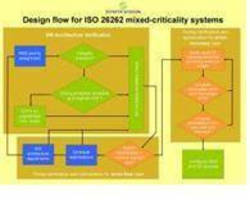Timing Design Software meets ISO 26262 requirements.
Share:
Press Release Summary:

Offering model-based solution for timing design, performance optimization, and timing verification for real-time systems, SymTA/S supports design of ISO 26262 compliant mixed-criticality automotive electronics systems, and overcomes inherent safety versus efficiency conflicts. Methodology meets primary ISO 26262 requirement to provide reliable coverage for failure and error-free scenarios by undertaking timing analyses to optimize and verify ECU software schedule.
Original Press Release:
SymTA/S Supports ISO 26262 Compliant Design of Mixed-Criticality Automotive Electronics Systems
The SymTA/S methodology meets primary ISO 26262 requirements for reliable coverage of failure and error-free timing scenarios, and overcomes inherent safety vs. efficiency conflicts
Braunschweig, Germany - Symtavision, the global leader for timing design and timing verification for embedded real-time systems, has announced that SymTA/S supports the design of ISO 26262 compliant mixed-criticality automotive electronics systems. The SymTA/S methodology overcomes the inherent safety versus efficiency conflicts, especially when 'freedom from interference' must be realized between software partitions with different criticality levels. The SymTA/S methodology uniquely meets the primary ISO 26262 requirement to provide reliable coverage for failure and error-free scenarios by undertaking timing analyses to optimize and verify the ECU software schedule. Crucial to this is the ability to use SymTA/S timing analyses to select configurations for OS services such as watchdog timeouts and timing protection budgets rather than simply react to timing failures while the target system is running.
"Designing for ISO 26262 is an extremely hot topic" said Dr. Marek Jersak, CEO of Symtavision. "With the advent of mixed-criticality ECUs in automotive electronic systems, the established design patterns for building ECU schedules are unsuitable as they trade off efficiency for safety. Using SymTA/S for the design of ISO 26262 compliant mixed-criticality automotive electronic systems allows ECU schedules to be created, analyzed, optimized and verified that are not only safe and certifiable but also efficient."
To build ISO 26262 compliant ECU schedules that are both safe and efficient, the SymTA/S methodology draws on a combination of the established RMS (Rate Monotonic Scheduling) and the recently proposed CAPA (Criticality As Priority Assignment) timing schedule strategies coupled with procedural guidelines, based on extensive SymTA/S timing analysis, on how safety can be verified and efficiency determined. RMS, which is currently used extensively in the industry, yields compact, resource-efficient pre-emptive timing schedules for AUTOSAR and OSEK, but it cannot cope with mixed-criticality requirements as priority is given to tasks with the shortest cycle time without reference to safety requirements and criticality levels. On the other hand, a CAPA strategy can ensure the necessary 'freedom from interference' between tasks that ISO 26262 demands but this comes at the cost of a significant reduction in resource efficiency.
Using timing analysis data from SymTA/S, the ISO 26262 compliant design methodology enriches key aspects of both the RMS and CAPA schedule design patterns with guidelines on how to select priorities, when and how to use Watchdogs or Timing Protection, and when the software architecture needs to be adapted in terms of cycle times and runnables-to-task mapping. Furthermore, SymTA/S reliably covers error-free and failure scenarios of various kinds, and hence provides evidence that the software and safety architectures are suitable.
"Already proven on real-world ISO 26262 compliant mixed-criticality automotive electronics systems, the SymTA/S is an invaluable aid for software architects in the planning phase of ECU software integration," concluded Dr. Marek Jersak, CEO of Symtavision. "The ability to select appropriate measures to ensure efficiency and certifiability as well as deliver safety at the lowest possible hardware cost is crucial to ISO 26262 ECU schedule design."
Notes to Editors
Dr. Marek Jersak, CEO of Symtavision will present a paper on "Freedom from Interference in Mixed-Criticality Systems According to ISO 26262" at the CTI International Conference ISO 26262, Detroit on 13th June 2012.
Christoph Ficek of Symtavision will present a paper "Schedule Design to Guarantee Freedom of Interference in Mixed-Criticality Systems" at the SAE 2012 World Congress on 25th April 2012 (Session AE300 - Safety Critical Systems).
About Symtavision
Symtavision® is a leader in embedded design software tools and services. The company enables the rapid and cost-effective planning, optimization and timing verification of complex, safety- and performance-critical embedded real-time systems - from early-phase estimation to final verification.
Symtavision's innovative scheduling analysis tool suite for system-level timing design and timing verification, SymTA/S, helps engineers conquer design challenges for controllers, processors, bus/networks and complete integrated systems. It is used extensively in automotive electronics with support provided for industry standards including AUTOSAR, CAN, FlexRay and OSEK, and in the avionics industry with support provided for ARINC 653 partitioned operating systems and ARINC 664 switched Ethernet, and time-triggered communication. SymTA/S also provides support for a variety of other industry sectors including the automation, multimedia, telecommunications and transportation markets. Symtavision's associated TraceAnalyzer is a powerful solution for visualizing and analyzing timing data from both measurements and simulations. TraceAnalyzer seamlessly integrates with SymTA/S.
Symtavision is headquartered in Braunschweig (Germany) with subsidiary offices in Munich (Germany) and Cologne (Germany) and is supported by a global network of distributors. Symtavision is also a founding member of the Real-Time Experts Alliance which was formed in 2008 to provide complete solutions for all timing challenges in real-time systems development. For more information visit: www.symtavision.com.
All trademarks are recognized and are the property of their respective companies.




